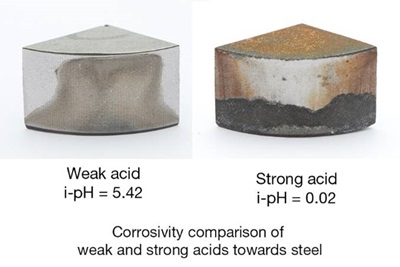We now have two methods for measuring the build-up of acids in an engine lubricant during service: TAN and i-pH. TAN is a titration method that measures the amount of acid in the lubricant; i-pH is a direct method that measures the strength of acid in the lubricant.
The distinction between the amount and the strength of acid is important. In the past, when vehicles were running on high sulfur fuel, the majority of acid that built up in the lubricant was a strong sulfur acid. Therefore, in the past measuring the amount of acid was equivalent to measuring the strength of the acid, so TAN was an appropriate method. For modern vehicles that use ultra-low sulfur fuel this is no longer the case. Now the acid contaminants in the lubricant can be a mixture of strong and weak acids, so measuring the amount of acid in the lubricant with TAN can be misleading. It is much more informative to measure the strength of the acid mixture instead with i-pH. This is because a large amount of weak acid does not pose a corrosive risk, whereas a small amount of strong acid does pose a corrosion risk – the key determining factor for corrosion is the acid strength. In the same way, a large amount of weakly acidic orange juice is far less corrosive than a small amount of strongly acidic hydrochloric acid.

Our View
Because TAN is no longer the most appropriate and meaningful way to measure the build-up of acids during an oil drain interval (ODI), the point at which TBN and TAN data cross over is no longer an accurate indicator of the end of a lubricant’s useful life. Instead, measuring wear metal content, oxidation and nitration of the lubricant, viscosity change, soot content, and adding in a measurement of i-pH using ASTM D7946, is the best way to ensure the integrity of your vehicle’s lubricant and of maximizing the lifetime and efficiency of your engine.
For additional information on the benefits of i-pH for used oil analysis, please contact your Lubrizol representative.









